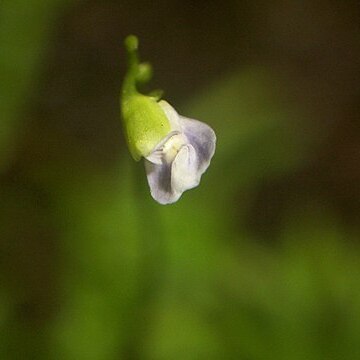Terrestrial. Rhizoids few capillary, basally thickened, with numerous papillose branches c. 1 mm long. Stolons few, capillary, branched, up to 6 cm long or more. Foliar organs often not conspicuous at anthesis, on the stolons, ovate to linear, membranous, up to 4 cm long, 1.5—6 mm wide, multinerved, apex obtuse to subacute. Traps on the stolons and foliar organs, globose, 1-2 mm long, shortly stalked, mouth basal, upper lip with 2 simple subulate appendages. Inflorescence erect, up to 30 cm long; peduncle filiform, terete, glabrous; flowers 2-10, rather distant; scales few, similar to the bracts; bracts basifixed, ovate, acuminate, 2-3 mm long, 3-nerved; bracteoles subulate, about half as long as the bract, 1-nerved; pedicels erect 1.5-2 mm long at anthesis, often spreading and up to 3 mm long in fruit, filiform distinctly winged. Calyx lobes subequal, very broadly ovate to almost orbicular, c. 2.5 mm long at anthesis, up to 5 mm long in fruit, surface minutely papillose, margin usually minutely denticulate, upper lobe slightly larger, apex very shortly acuminate, lower with apex shortly bifid. Corolla blue, violet, mauve or white, 3-7 mm long, upper lip ± orbicular scarcely longer than upper calyx lobe, apex rounded, emarginate or ± bifid, lower lip larger, ± orbicular, apex rounded, entire or ± obscurely 3-crenate, palate raised, gibbous, spur conical-subulate, acute, curved or ± straight, longer than and widely diverging from the lower lip. Filaments linear, curved, c. 1.5 mm long, anther thecae distinct. Ovary ovoid, style short but distinct, stigma lower lip quadrate, upper lip obsolete. Capsule broadly ellipsoid, dorsiventrally compressed, 2-4 mm long uniformly membranous, dehiscing by dorsal and ventral longitudinal slits. Seeds numerous, ± globose or very broadly ellipsoid, c. 0.3-0.4 mm long, testa thin, conspicuously reticulate, reticulations ± regularly hexagonal isodiametric or very slightly elongate, hilum not prominent.
More
Annuals, terrestrial. Rhizoids and stolons capillary, branched. Traps on rhizoids, stolons, and leaves, stalked, globose, 1-1.5 mm, glandular, mouth basal; appendages 2, dorsal, subulate, stipitate. Leaves few to numerous, at stolon nodes, glabrous; leaf blade linear to narrowly obovate, 2.5-4.5 cm × 1.5-6 mm, membranous, veins 3, base attenuate onto petiole, margin entire, apex rounded to acute. Inflorescences erect, 3-12 cm, 1-10-flowered, glabrous; peduncle slightly angular, 0.2-0.5 mm thick; scales few, similar to bracts; bracts basifixed, narrowly ovate, 0.8-1 mm, apex acute. Pedicel suberect, 1-1.5 mm at anthesis but to 5 mm in fruit, filiform, narrowly winged; bracteoles narrowly linear to subulate, slightly shorter than bract, apex acute. Calyx lobes broadly ovate to suborbicular, 2.5-5 mm, margin minutely denticulate; lower lobe slightly smaller than upper lobe, apex emarginate; upper lobe apex obtuse to subacute. Corolla lilac, violet, or white, 3-7 mm; lower lip suborbicular, base much swollen, apex rounded to emarginate; spur subulate, ± as long as lower corolla lip, widely divergent, apex acute; palate with a ciliate marginal rim; upper lip oblong, scarcely longer than upper calyx lobe, apex rounded to emarginate. Filaments ca. 1 mm, straight; anther thecae distinct. Ovary ovoid, dorsiventrally compressed; style short but evident; stigma lower lip semicircular, upper lip obsolete. Capsule ovoid, 2-4 mm, dorsiventrally compressed, dehiscing by dorsal and ventral longitudinal slits. Seeds subglobose, 0.3-0.4 mm in diam.; seed coat with prominent isodiametric reticulations. Fl. Jun-Oct, fr. Jul-Nov.


